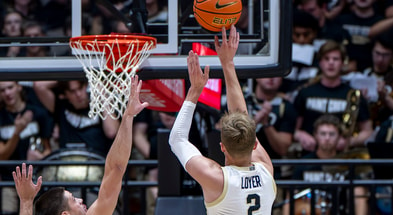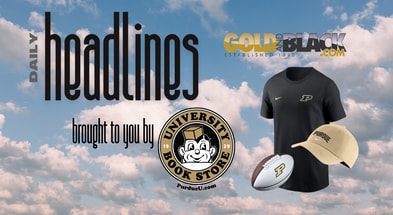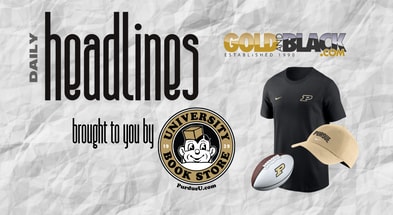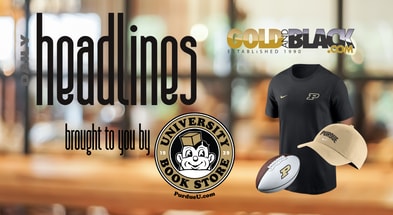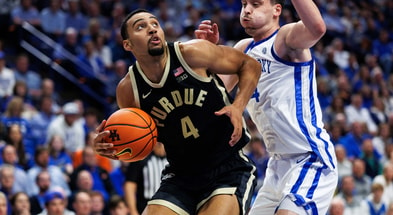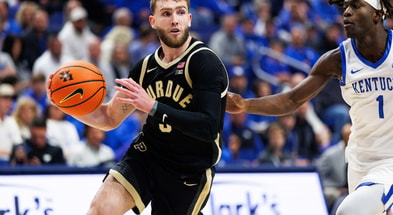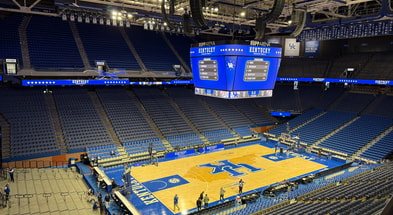Pacers-Purdue ties go beyond most recent title

Although the Indiana Pacers are the “home” NBA team for many Purdue basketball fans, currently there are no direct ties between the two teams. But that wasn’t always the case. Far from it.
Purdue supporters played a significant role in the business dealings that led to the formation of the Pacers in the fledgling pro league in 1967. Two of its star players were part of the Pacers’ three ABA titles from 1970 to 1973. Even its athletic trainer, who spent 35 years with the Pacers, was a Purdue graduate and had worked with Boilermaker teams before heading to Indianapolis. The Boilermakers’ most recent NBA All-Star achieved that status while in Indianapolis.

Foundation laid at the Lafayette Country Club
With the Pacers in the NBA Finals for the first time in a quarter century, Pacers fans are dreaming of their first pro basketball title in 52 years. However, it took some Lafayette-area businesspeople and Purdue supporters to get the Pacers launched in time for the 1967-68 season. At the annual dinner at the Lafayette Country Club, a stag affair where elk, boar and other wild game were served, Indy Star sports editor Bob Collins, who regularly attended the annual dinner, spoke about the effort to start a new league.
“The entry fee was reasonable, something like $6,000,” said Mark Monteith, a long-time sports writer who has covered the Pacers for years and wrote a book on the topic of pro hoops returning to the Circle City. “And these guys are sitting around a table, and it’s like, hey, let’s do it. So everybody puts in $1,000 and area bank president (and Purdue donor) Joe Bannon went to New York City to deliver the money. Of course, it took a lot more than that later on to have a franchise, but that was putting dibs down on a franchise, and that all came from that dinner at the Lafayette Country Club.”
Dick Ebershoff, who might be best described as a Purdue NIL supporter decades before the term “NIL” was coined, was also involved. So was Lyn Treece who played a key financial role in the Pacers acquiring Mel Daniels, a future Hall of Famer who immediately turned the Pacers into a league contender.
If not for that deal, the Pacers would have folded (like several other charter members of the league) as they were just a very average team, and we’re not drawing well that first year,” Montieth said. “If you don’t bring in Mel Daniels, you’re never going to win a championship. And if you don’t do that, the Pacers might have folded after two or three years. And if the Pacers folded, the ABA probably would have folded. That effort by Treece, in many ways, saved the Pacers and saved the ABA.”
Purdue legends played key roles in Pacers’ trio of titles
Rick Mount and Billy Keller led Purdue to the national title game in 1969, and soon after took their games to the Pacers. Keller, a late-round draft pick, was not expected to make the 1969-70 team, but as would be the case during his seven seasons with the Pacers, he managed to earn a spot. Keller would become one of just four players to participate on all three title teams and would go on to become one of the most popular players in franchise history.
“Keller is one of the nicest guys off the court, but he was very competitive on it,” Montieth said. “And he was a great shooter and that helped him stay on the squad.”
The ABA was the originator of the three-pointer, along with the red, white, and blue basketball. That “three” was Keller’s ticket to longevity and the reason that the Pacers signed Mount to a $1 million contract a year later.
But for Mount, it wasn’t so easy. Pacers’ coach Bobby Leonard (of “Boom Baby” Pacers’ radio network color analyst fame for more recent fans never wanted “The Rocket”. Whether it was because Mount stole some of the attention away from Leonard or he just wasn’t a fit for Leonard’s plans is debated decades later, but Mount lasted just two seasons with the Pacers. When Mount signed his contract, it was broadcast live on prime-time Indianapolis television (Channel 13). Leonard didn’t attend, saying he had a cold.
“After being injured in his first season, Rick had some really good games with the Pacers,” Montieth said. “He would score 28 points here, and 22 points there, and started a lot of games in the 1972 title year.”
Mount ended up asking for a trade, a story that came out during the ’72 championship series. The following year, he was with the Kentucky Colonels — coincidentally, the Pacers’ title series victim in 1973.
“Rick was not a bust in the pros like some think,” Montieth said. “He had hard luck with injuries, and after five years, left pro ball on his terms. He even was in the Pacers’ camp as a free agent, because Leonard felt guilty about how he treated Mount, but after a day or two, Mount decided his heart wasn’t in it anymore and walked out of camp, and that was the end of his pro career.”
Top 10
- 1New
YouTube TV, ESPN dispute
Google blasts ABC
- 2
College Football Playoff
Teams that remain in the hunt
- 3Hot
BCS Formula
Predicts first CFP Top 25
- 4
CFP Top 25 predictions
Projecting first rankings
- 5Trending
Auburn Hot Board
Top candidates to replace Freeze
Get the Daily On3 Newsletter in your inbox every morning
By clicking "Subscribe to Newsletter", I agree to On3's Privacy Notice, Terms, and use of my personal information described therein.
The beloved Keller was also treated harshly at the end of his playing days. After trying to return from injury, Keller was cut from the squad the night before the Pacers were to play the Bulls in an exhibition game at Mackey Arena.
“It bothers Billy to this day,” Montieth said. “Couldn’t they have kept him one more day on the roster?”
Sichting goes from Walter Mitty to starter
The Pacers were in financial hot water after they became one of four former ABA teams invited to join the NBA for the 1976-77 season. As a result, they held a telethon, led by Leonard, to save the franchise. And it didn’t help that the Pacers had some awful teams in those first years. However, it presented an opportunity for former Boilermaker standout guard Jerry Sichting (1976-79).
After being drafted in the fourth round by Golden State (there were seven or more rounds in those days), Sichting, a Martinsville, Indiana native who was a senior captain on coach Lee Rose’s ’79 Big Ten title team, was cut and left the basketball scene in 1979-80, resorting to selling sporting goods in central Indiana and playing pickup ball. Sichting participated in a “Walter Mitty” tryout of local talent at Butler’s Hinkle Fieldhouse and was by far the best player. He made the team and ended up being a two-year starter before having an opportunity to win an NBA title with Larry Bird and the Celtics in 1986.
Sichting went on to play a decade in the league and spent three decades as an NBA assistant coach.
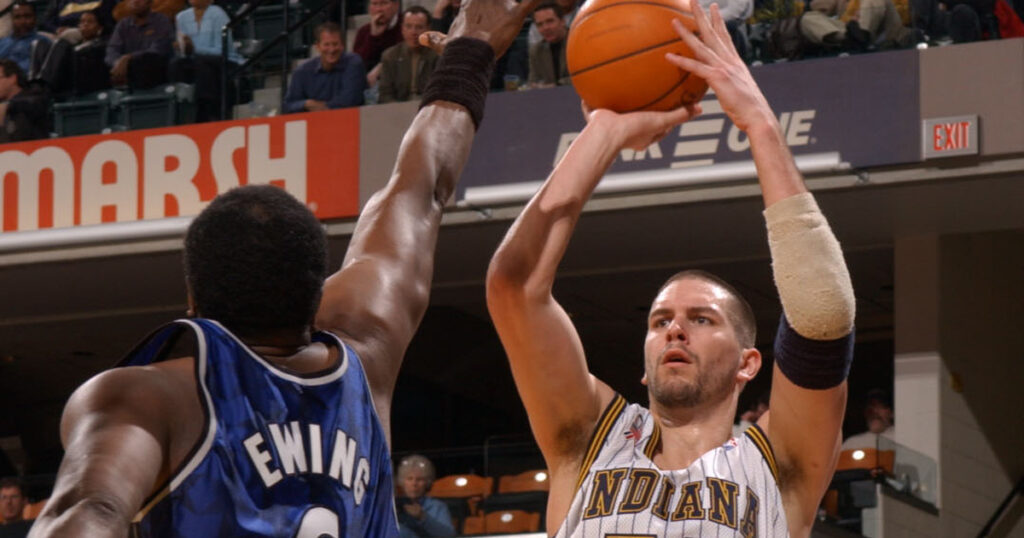
Stephens, Miller have short stints
Everette Stephens, of Purdue’s famed “Three Amigos” was tabbed by the 76ers in the 1988 NBA Draft, but promptly traded to the Pacers. Stephens played about 40 games in Indy in the 1989 season, as the Pacers coveted him enough to make a deal for him. Unfortunately, a year later, Stephens was gone, though he enjoyed a decade-long pro career in Australia. Troy Lewis, Stephens’ backcourt mate on the Boilermakers Big Ten title teams in 1987 and ’88, got a tryout with the Pacers, though he wasn’t drafted. He didn’t make the team.
For Brad Miller, the story was much different. Acquired from the Bulls in a blockbuster trade involving Jalen Rose and many others, the Kendallville, Indiana native earned the first of his two All-Star opportunities with the Pacers.
“The Pacers really needed a center as Jermaine O’Neal was better suited at forward,” Montieth said. Miller played decade of NBA basketball for a handful of teams, and made a whole lot of money. The Pacers wanted to keep him after his All-Star Season, but the bidding for him was crazy, Brad himself said it went crazy as a huge surprise to him, and the Pacers simply could not afford to keep him. They were willing to pay him, like 60 or $70 million, but he got, like $120 million from Sacramento, so they worked out a sign and trade.”
Keller went on to participate in community service opportunities with the Pacers in his later years, solidifying his status as a beloved guy. And the trainer who was a Pacers’ fixture? David Craig, of course, was mentored by the Boilermakers’ legendary trainer William “Pinky” Newell and logged nearly four decades with the Pacers, outlasting multiple coaches and ownership groups in his Hall of Fame career.
Note: Montieth tells many more interesting stories in the middle segment of our May 31st edition of Saturday Simulcast.
More on Purdue basketball: TKR sharpens skills and mind in off-season work
